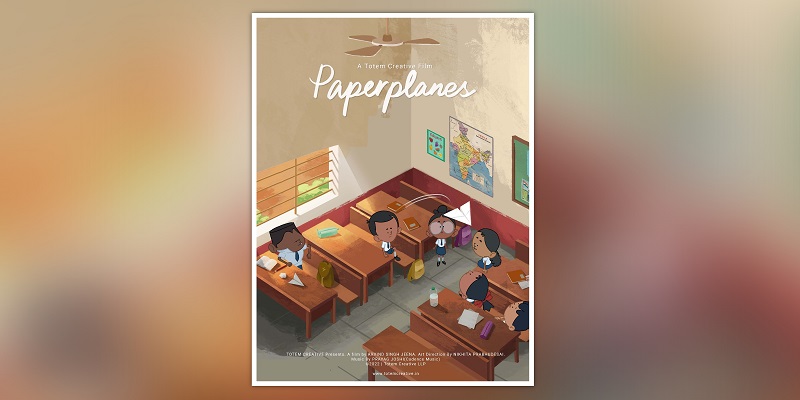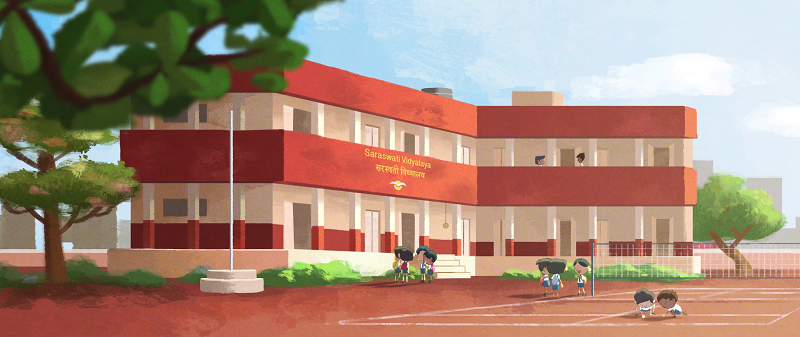The memory of drawing classes, the sound of ringing bells, and the sight of everyone rushing to their classes upon spotting the teacher, evoke a profound sense of nostalgia. Expanding on this delightful theme and transporting the viewers back to their school days, the animated short Paperplanes strikes all the right chords.
Set in an Indian classroom, this independent animated short produced by Totem Creative has been globetrotting in the festival circuit starting with Animator’s Guild India Festival ’22, Mumbai, Annecy International Animation Film Festival, Stuttgart International Festival of Animated Film (ITFS) and few more international festivals. In a detailed interview with Animation Xpress, Totem Creative founder and creative head Arvind Singh Jeena shared how Paperplanes, which started as a college project, took off on its global journey.
Read to know more about the poignant story of the animated short and its creators:
1) To begin with, please share something about the journey of Totem Creative.
Totem Creative kind of happened very suddenly, we were still fresh out of college when we decided to take this road, with no prior industry experience. We don’t know whether that was a bold decision or a foolish one. Nevertheless, we started Totem with a long term vision of creating original Indian content, our own stories and IPs. It took a while, but slowly and steadily we have managed to produce two independent short films. And the second one made it to the ANNECY! which makes us feel we are doing something right.
Of course, it has been a huge challenge to keep growing, creatively as well as financially. Not to forget the pandemic! The lockdown was particularly hard for our industry. So there is no understating that the journey has been one hell of a roller-coaster ride. But the fact that we are still here and kicking makes us super proud and pushes us to keep going.
2) Your short film Paperplanes brings a sense of nostalgia for the viewers. How did you come up with this concept?
The nostalgia is in all of us. The film simply reflects on it. While making this film we realised how we all went through surprisingly common experiences in our childhood, in school. From North to South, you’ll find the same school buildings, same benches, the same diagrams on the walls. Even the games we played as kids were the same-pen fights, chor-police, vish-amrit (Lock & Key) etc. The experience is almost the same and true. This is the part that people have loved about the film the most.
Apart from that, the concept of the film is very simple. It encourages creativity and originality, even if in small ways. It is NOT a unique story, told for the first time, but one that the audiences need to be reminded of every now and then. That has largely been the motivation behind the story and this film.
3. Please tell me about the team size of your studio.
We are a small team. Not more than six to eight at any given point. Five of us are in the core team working full time, and rest are interns/trainees who join Totem for a shorter duration.
4. How long did you take to complete Paperplanes and how many artists were involved at various stages.
The production team mainly consisted of six people including one storyboard artist and art director, one vis-dev artist, one animator (Yeah! 80 per cent of the film is animated by Gaurav Dhaimodkar, at Totem), one character designer, one sound designer, one compositing artist. We did have two or three interns at different stages over the years, which helped with initial explorations, a few animation shots, some cleanup and colour etc.
It took us almost five years until the final cut of the film. For the first or second year, it was just Nikhita (my partner) and I working on the story and animatics occasionally, some character designs on the side. A major chunk of our time was still going into commissioned work and sustaining the studio. But gradually, we were doing a little better so we started getting internship enquiries. There we found some really passionate students/artists who worked on the film in different capacities, at different times.
5. Your story reminds me of carefree childhood days, finding joy in little things and so on. It also shows the uniqueness of every child. Is there any other message that you wanted to convey?
That is the message. As you rightly said, kids are unique and original. Until they have to adapt to our education system, which for the most part looks at academics for merit. Creativity, art are not valued as much. Even in many design colleges today, the courses are conducted in an academic fashion, from assignment to assignment. This only yields skilled professionals, not necessarily creative individuals.
6. Animation as a medium has a universal tone. Silent stories or using gibberish language (like Pingu) find more takers all around the world. Do you agree?
Absolutely! Through animation you can communicate any idea without scrutinising where the idea is coming from. You can question ideals, impart moral wisdom, talk about sensitive, complicated subjects without ever pointing at someone.
Same goes for language. That’s why Charlie Chaplin, Buster Keaton can still speak to the audience today. The old Disney cartoons, Looney Tunes, Tom & Jerry reached audiences world wide because they broke the language barrier. And now we have Lamput an Indian IP, from Vaibhav Studios, which has the same transcendent quality.
7. According to you, what is the role of music and sound design?
One of the important learnings from Paperplanes was that good sound design and music makes up for half of the storytelling.
Music can help set the mood and context. It informs the audience of something that is perhaps not on the screen. Often ‘showing’ or ‘telling’ is not enough; the audience needs to feel it. Music has that penetrating quality. It is truly a universal language. That’s why the filmmakers or directors who possess a keen sense of sound and music, excel in their craft.
8. When you tell a story, do you think it should appeal to a broader age group? For instance, children as well as elders will connect with Paperplanes. So how do you ensure that?
Not always. For Paperplanes, we certainly didn’t give this much thought. We were more focused on telling this story in our way. We honestly didn’t think that kids would find meaning in it. It was intended for young adults or adults. In hindsight, we managed to create a rich world full of characters that everyone can relate to. Everyone in India has been in a classroom like that. We all have friends similar to the characters of the film. In fact many of the characters are based on our classmates back in primary school.
9. Please talk about the animation style used. It would be great if you talk about software & technology used.
It is hand drawn, frame by frame animation. I have always found a certain charm in sketches/drawings moving. It’s really like magic. That’s the kind of animation we had set out to produce from the very beginning. Though, it wasn’t very practical to use hand drawn animation in commercial space. But when it came to making our own films, there was no question of doing it any other way. Over the years we have gotten better and much faster at it. Now we do hand drawn animation even on commercial projects, TVCs.
For the film, a lot of early sketches, thumbnails and character designs were done on paper/sketchbooks. The pre-production was largely done on Adobe Photoshop, from final storyboard to visual design; background, character design etc. were done on Ps. For animation production we used TVPaint for everything from rough animation to final colours. Lastly the entire compositing process was done in AfterEffects.
10. Is there anything else that you would want to share about this project?
I am just thrilled to see the journey of this film, which started as a college project and went to premier at some of the biggest festivals in the world. It’s funny how many times we thought of scrapping it and moving on, under the pressure. It is really difficult to stay motivated on a project this long. But I am glad we did, and finished it.
11. What are the other projects Totem Creative is involved in at the moment?
There are a few commissioned projects in production which are quite exciting. We are also collaborating on an international short film project. Apart from that we are anticipating some releases that we produced in collaboration last year and early this year.
In IPs, we want to create animated TV shows for mature audiences here in India, next. We are working on a show called Trash Mountain. It is still in a very early stage of development. Right now we are bouncing the idea around and taking reactions from peers. But we are excited about its potential.




